2023 SUBARU BRZ engine oil
[x] Cancel search: engine oilPage 203 of 432
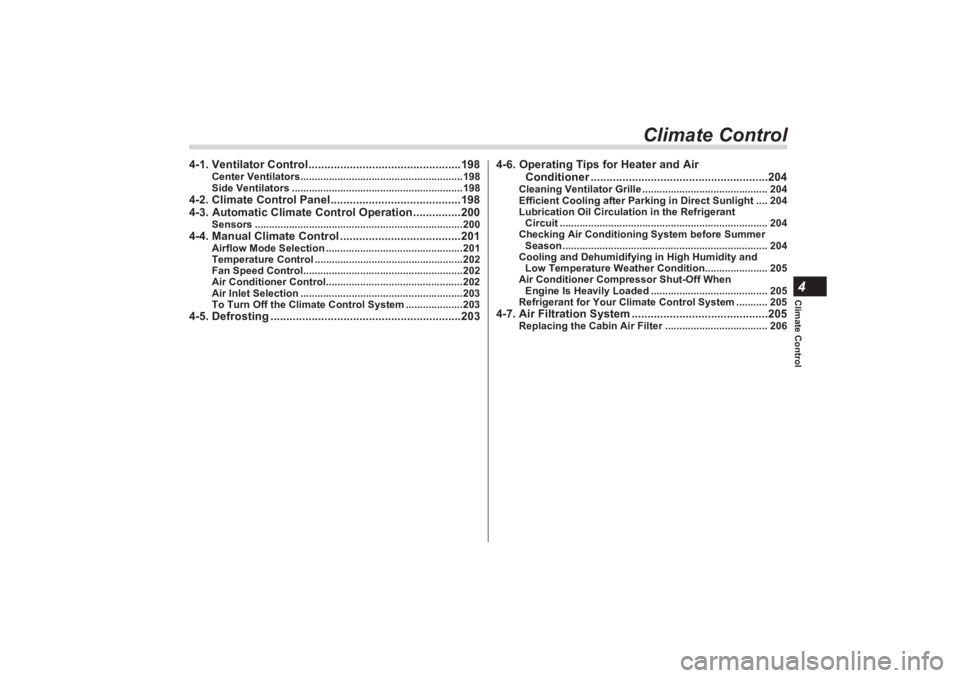
Climate Control4
Climate Control
4-1. Ventilator Control................................................198
Center Ventilators.........................................................198
Side Ventilators ............................................................198
4-2. Climate Control Panel.........................................198
4-3. Automatic Climate Control Operation...............200
Sensors .........................................................................200
4-4. Manual Climate Control ......................................201
Airflow Mode Selection ................................................201
Temperature Control ....................................................202
Fan Speed Control........................................................202
Air Conditioner Control................................................202
Air Inlet Selection .........................................................203
To Turn Off the Climate Control System ....................203
4-5. Defrosting ............................................................203 4-6. Operating Tips for Heater and Air
Conditioner ......... ....................................... ........204
Cleaning Ventilator Grille ............................................ 204
Efficient Cooling after Parking in Direct Sunlight .... 204
Lubrication Oil Circulation in the Refrigerant
Circuit ......................................................................... 204
Checking Air Conditioning System before Summer Season ........................................................................ 204
Cooling and Dehumidifying in High Humidity and
Low Temperature Weather Condition...................... 205
Air Conditioner Compressor Shut-Off When
Engine Is Heavily Loaded ......................................... 205
Refrigerant for Your Climate Control System ........... 205
4-7. Air Filtration System ...........................................205
Replacing the Cabin Air Filter .................................... 206
BRZ_U.book 197 ページ 2022年3月29日 火曜日 午後3時59分
Page 210 of 432
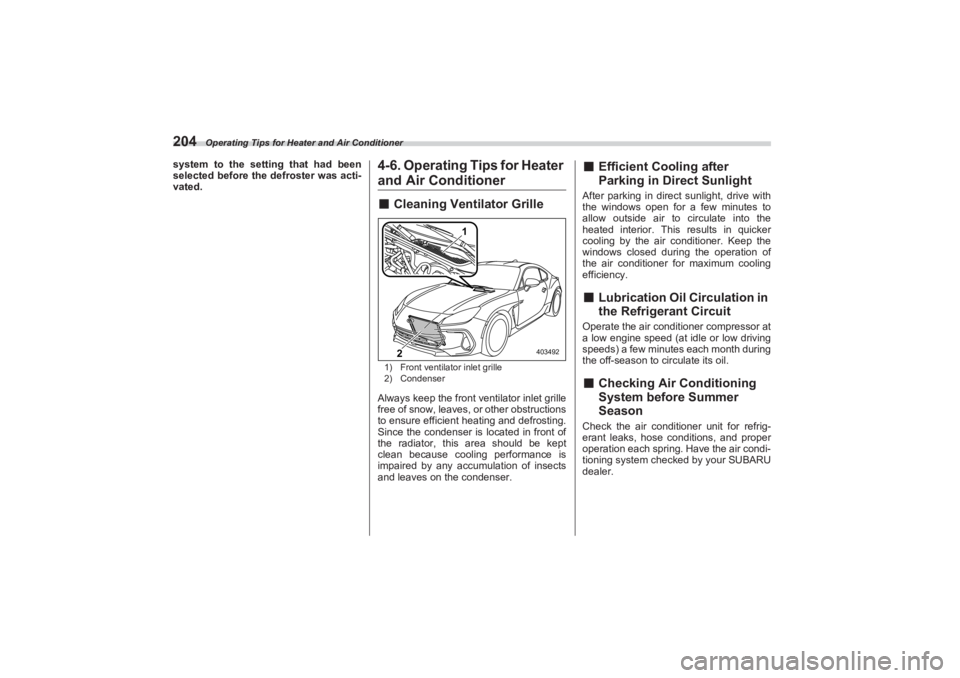
Operating Tips for Heater and Air Conditioner
204system to the setting that had been
selected before the defroster was acti-
vated.
4-6. Operating Tips for Heater and Air Conditioner■ Cleaning Ventilator Grille1) Front ventilator inlet grille
2) CondenserAlways keep the front ventilator inlet grille
free of snow, leaves, or other obstructions
to ensure efficient heating and defrosting.
Since the condenser is located in front of
the radiator, this area should be kept
clean because cooling performance is
impaired by any accu mulation of insects
and leaves on the condenser.
■ Efficient Cooling after
Parking in Direct SunlightAfter parking in direct sunlight, drive with
the windows open for a few minutes to
allow outside air to circulate into the
heated interior. This results in quicker
cooling by the air conditioner. Keep the
windows closed during the operation of
the air conditioner for maximum cooling
efficiency.■ Lubrication Oil Circulation in
the Refrigerant CircuitOperate the air conditioner compressor at
a low engine speed (at idle or low driving
speeds) a few minutes each month during
the off-season to circulate its oil.■ Checking Air Conditioning
System before Summer
SeasonCheck the air conditioner unit for refrig-
erant leaks, hose conditions, and proper
operation each spring. Have the air condi-
tioning system checked by your SUBARU
dealer.
2
1
403492
BRZ_U.book 204 ページ 2022年3月29日 火曜日 午後3時59分
Page 235 of 432

Starting and Stopping Engine
229
Starting and Operating7
– CONTINUED –
NOTEEngine oil, engine coolant, brake fluid,
washer fluid and other fluid levels
should be checked daily, weekly or at
fuel stops.
7-4. Starting and Stopping Engine■Safety PrecautionsRefer to "Safety Precautions" P94.■Operating Range for Push-
Button Start SystemRefer to "Operating Range for Push-
Button Start System" P125.■ General Precautions When
Starting Engine
NOTEIt may be difficult to start the engine
when the battery has been discon-
nected and reconnected (for mainte-
nance or other purposes). This
difficulty is caused by the electroni-
cally controlled throttle’s self-diag-
nosis function. To overcome it, keep
the ignition switch in the “ON” position
for approximately 10 seconds before
starting the engine.
Avoid rapid racing and rapid accel-
eration immediately after the engine
has started.
After the engine starts, the engine
speed will be kept high.
CAUTION
Small animals trapped in the cool-
ing fan and belt of the engine may
result in a malfunction. Check that
no small animal enters the engine
compartment and under the vehicle
before starting the engine.
WARNING
Never start the engine from
outside the vehicle. It may result
in an accident. Do not leave the engine running
in locations with poor ventilation,
such as a garage and indoors.
The exhaust gas may enter the
vehicle or indoors, and it may
result in carbon monoxide
poisoning.
Do not start the engine near dry
foliage, paper, or other flammable
substances. The exhaust pipe
and exhaust emissions can
create a fire hazard at high
temperatures.
CAUTION
If the engine is stopped during
driving, the catalyst may overheat
and burn. When starting the engine, be sure
to sit in the driver’s seat.
BRZ_U.book 229 ページ 2022年3月29日 火曜日 午後3時59分
Page 245 of 432

Automatic Transmission
239
Starting and Operating7
– CONTINUED –
3. While depressing the brake pedal,
insert the screwdriver into the hole, press
the shift lock release portion using the
screwdriver, and then move the select
lever.
If the select lever does not move after
performing the above procedure, the shift
lock system may be malfunctioning.
Contact a SUBARU dealer for an inspec-
tion as soon as possible.■ Selection of Manual Mode▼ Selecting gears in manual modeShift the select lever to the “M” position to
change to manual mode.
When the upshift/downshift indicators are
illuminated, the vehicle can be driven in a
selected gear by shifti ng the select lever toward “-” or “+” or operating the “-” or “+”
shift paddle.
1) Upshift indicator
2) Downshift indicator
3) Upshift
4) Downshift
The gear changes once each time the
select lever or a shift paddle is operated.
The selected gear, from “M1” to “M6”, will
be displayed on the combination meter.
When in manual mode, the gear will not
change unless the select lever or a shift
paddle is operated, except in the following
situations.
When the vehicle speed drops
(downshift only)
When the engine oil temperature is
high and the engine speed approaches
close to the red zone
If an upshift is atte mpted while the vehicle
speed is low, the gear will not be changed.NOTE If a downshift is attempted at a
vehicle speed where a downshift is not
possible (when the engine speed
would enter the red zone if a downshift
is performed), the downshift warning
buzzer will sound to inform the driver
that a downshift cannot be performed.
You can perform a skip-shift (for
example, from 4th to 2nd) by operating
702770
13
4
2
3
4702773
CAUTION
Do not place or hang anything on
the shift paddles. Doing so may
result in accidental gear shifting.
BRZ_U.book 239 ページ 2022年3月29日 火曜日 午後3時59分
Page 246 of 432
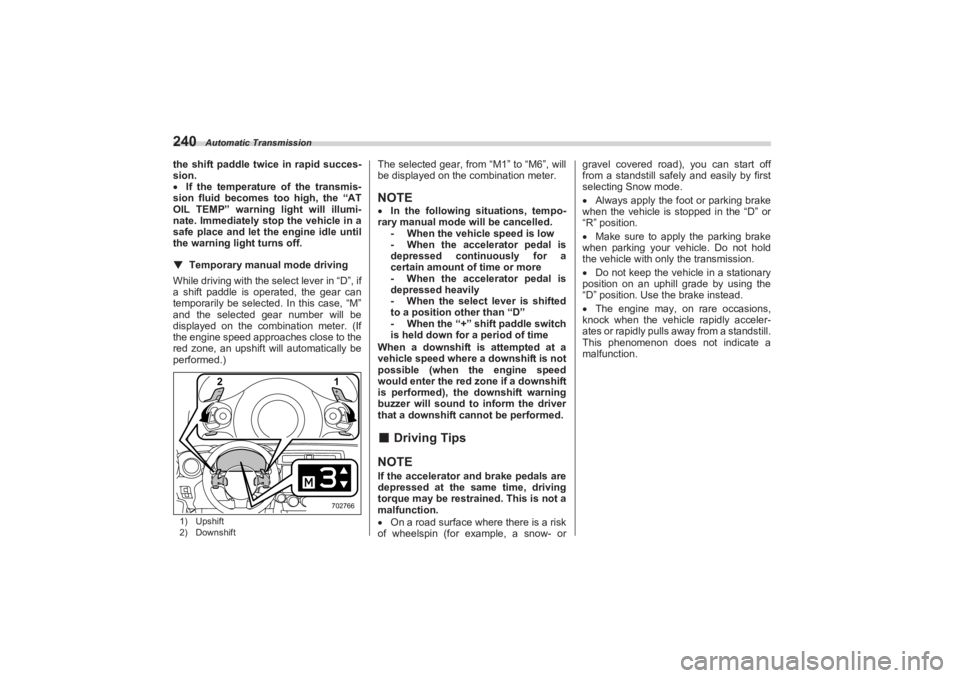
Automatic Transmission
240the shift paddle twice in rapid succes-
sion.
If the temperature of the transmis-
sion fluid becomes too high, the “AT
OIL TEMP” warning light will illumi-
nate. Immediately stop the vehicle in a
safe place and let the engine idle until
the warning light turns off.▼ Temporary manual mode driving
While driving with the select lever in “D”, if
a shift paddle is operated, the gear can
temporarily be selected. In this case, “M”
and the selected gear number will be
displayed on the combination meter. (If
the engine speed approaches close to the
red zone, an upshift will automatically be
performed.)1) Upshift
2) Downshift
The selected gear, from “M1” to “M6”, will
be displayed on the combination meter.NOTE In the following situations, tempo-
rary manual mode will be cancelled. - When the vehicle speed is low
- When the accelerator pedal is
depressed continuously for a
certain amount of time or more
- When the accelerator pedal is
depressed heavily
- When the select lever is shifted
to a position other than “D”
- When the “+” shift paddle switch
is held down for a period of time
When a downshift is attempted at a
vehicle speed where a downshift is not
possible (when the engine speed
would enter the red zone if a downshift
is performed), the downshift warning
buzzer will sound to inform the driver
that a downshift cannot be performed.■ Driving TipsNOTEIf the accelerator and brake pedals are
depressed at the same time, driving
torque may be restrained. This is not a
malfunction.
On a road surface where there is a risk
of wheelspin (for example, a snow- or gravel covered road), you can start off
from a standstill safely and easily by first
selecting Snow mode.
Always apply the foot or parking brake
when the vehicle is stopped in the “D” or
“R” position.
Make sure to apply the parking brake
when parking your vehicle. Do not hold
the vehicle with only the transmission.
Do not keep the vehicle in a stationary
position on an uphill grade by using the
“D” position. Use the brake instead.
The engine may, on rare occasions,
knock when the vehicle rapidly acceler-
ates or rapidly pulls away from a standstill.
This phenomenon does not indicate a
malfunction.
1
2702766
BRZ_U.book 240 ページ 2022年3月29日 火曜日 午後3時59分
Page 262 of 432
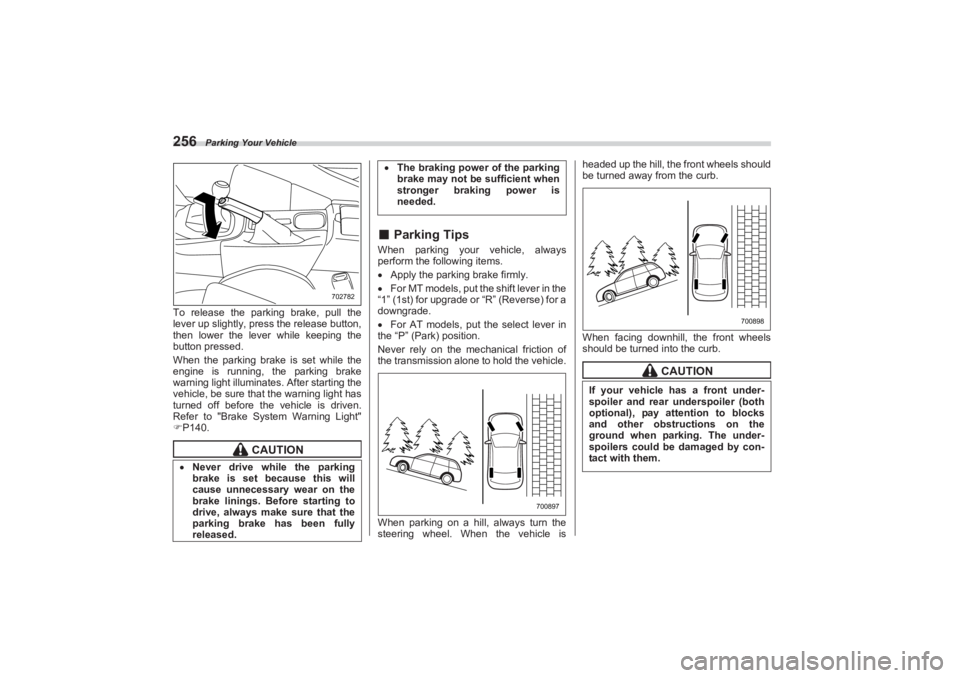
Parking Your Vehicle
256To release the parking brake, pull the
lever up slightly, press the release button,
then lower the lever while keeping the
button pressed.
When the parking brake is set while the
engine is running, the parking brake
warning light illuminates. After starting the
vehicle, be sure that the warning light has
turned off before the vehicle is driven.
Refer to "Brake System Warning Light"
P140.
■ Parking TipsWhen parking your vehicle, always
perform the following items.
Apply the parking brake firmly.
For MT models, put the shift lever in the
“1” (1st) for upgrade or “R” (Reverse) for a
downgrade.
For AT models, put the select lever in
the “P” (Park) position.
Never rely on the mechanical friction of
the transmission alone to hold the vehicle.
When parking on a hill, always turn the
steering wheel. When the vehicle is headed up the hill, the front wheels should
be turned away from the curb.
When facing downhill, the front wheels
should be turned into the curb.
CAUTION
Never drive while the parking
brake is set because this will
cause unnecessary wear on the
brake linings. Before starting to
drive, always make sure that the
parking brake has been fully
released.
702782
The braking power of the parking
brake may not be sufficient when
stronger braking power is
needed.
700897
CAUTION
If your vehicle has a front under-
spoiler and rear underspoiler (both
optional), pay attention to blocks
and other obstructions on the
ground when parking. The under-
spoilers could be damaged by con-
tact with them.
700898
BRZ_U.book 256 ページ 2022年3月29日 火曜日 午後3時59分
Page 299 of 432
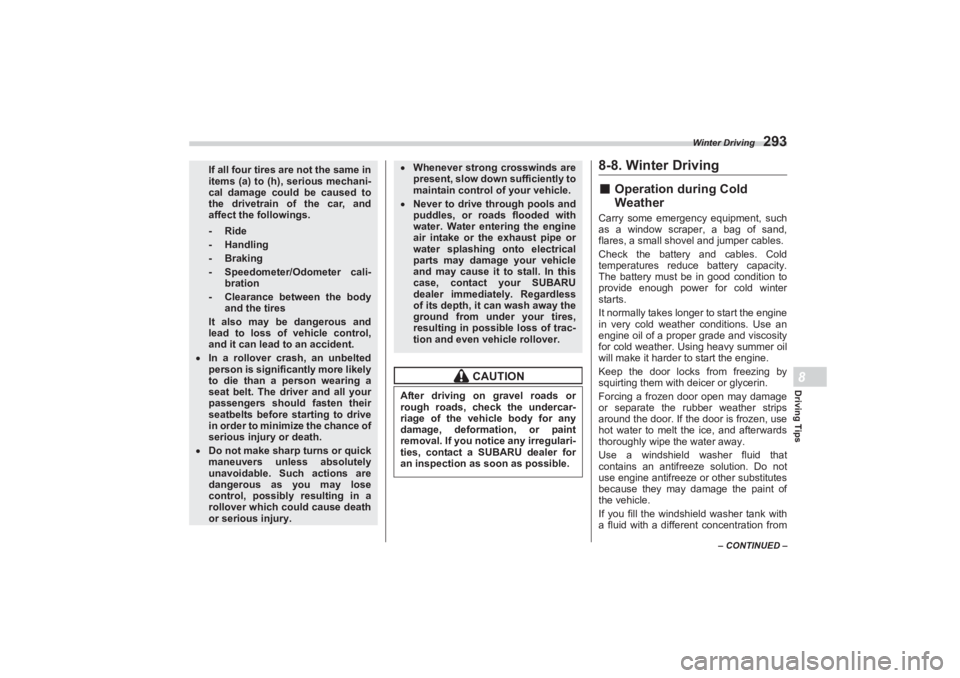
Winter Driving
293
Driving Tips8
– CONTINUED –
8-8. Winter Driving■Operation during Cold
WeatherCarry some emergency equipment, such
as a window scraper, a bag of sand,
flares, a small shovel and jumper cables.
Check the battery and cables. Cold
temperatures reduce battery capacity.
The battery must be in good condition to
provide enough power for cold winter
starts.
It normally takes longer to start the engine
in very cold weather conditions. Use an
engine oil of a proper grade and viscosity
for cold weather. Using heavy summer oil
will make it harder to start the engine.
Keep the door locks from freezing by
squirting them with deicer or glycerin.
Forcing a frozen door open may damage
or separate the rubber weather strips
around the door. If the door is frozen, use
hot water to melt the ice, and afterwards
thoroughly wipe the water away.
Use a windshield washer fluid that
contains an antifr eeze solution. Do not
use engine antifreeze or other substitutes
because they may damage the paint of
the vehicle.
If you fill the windshield washer tank with
a fluid with a different concentration from
If all four tires are not the same in
items (a) to (h), serious mechani-
cal damage could be caused to
the drivetrain of the car, and
affect the followings.-Ride-Handling- Braking- Speedometer/Odometer cali-
bration- Clearance between the body
and the tires
It also may be dangerous and
lead to loss of vehicle control,
and it can lead to an accident.
In a rollover crash, an unbelted
person is significantly more likely
to die than a person wearing a
seat belt. The driver and all your
passengers should fasten their
seatbelts before st arting to drive
in order to minimize the chance of
serious injury or death. Do not make sharp turns or quick
maneuvers unless absolutely
unavoidable. Such actions are
dangerous as you may lose
control, possibly resulting in a
rollover which could cause death
or serious injury.
Whenever strong crosswinds are
present, slow do wn sufficiently to
maintain control of your vehicle. Never to drive through pools and
puddles, or roads flooded with
water. Water entering the engine
air intake or the exhaust pipe or
water splashing onto electrical
parts may damage your vehicle
and may cause it to stall. In this
case, contact your SUBARU
dealer immediat ely. Regardless
of its depth, it can wash away the
ground from under your tires,
resulting in possible loss of trac-
tion and even vehicle rollover.
CAUTION
After driving on gravel roads or
rough roads, check the undercar-
riage of the vehicle body for any
damage, deformation, or paint
removal. If you notice any irregulari-
ties, contact a SUBARU dealer for
an inspection as soon as possible.
BRZ_U.book 293 ページ 2022年3月29日 火曜日 午後3時59分
Page 325 of 432
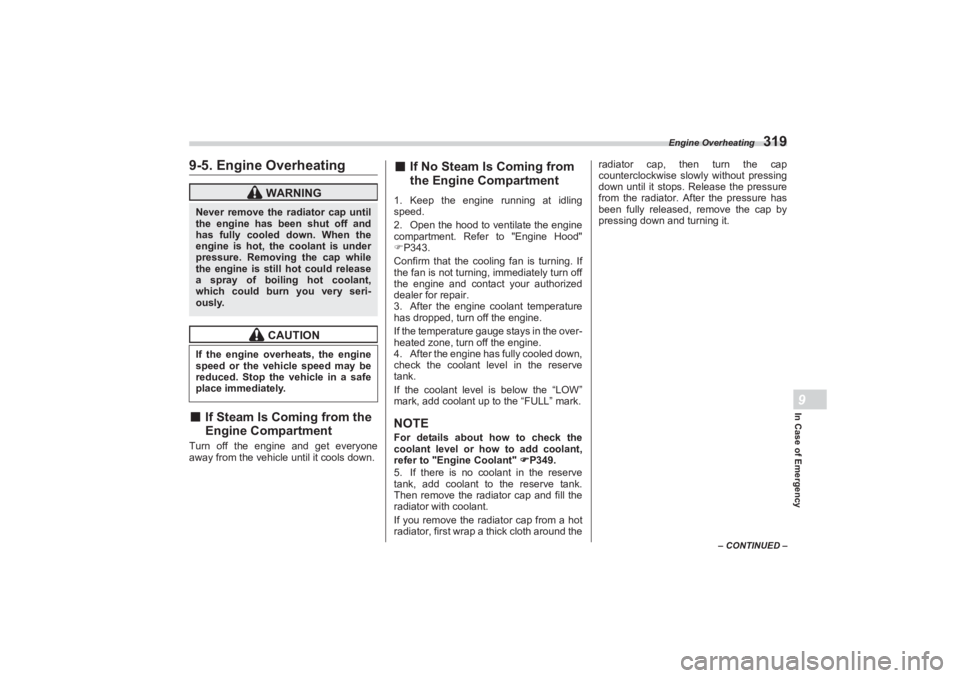
Engine Overheating
319
In Case of Emergency9
– CONTINUED –
9-5. Engine Overheating■If Steam Is Coming from the
Engine CompartmentTurn off the engine and get everyone
away from the vehicle until it cools down.
■ If No Steam Is Coming from
the Engine Compartment1. Keep the engine running at idling
speed.
2. Open the hood to ventilate the engine
compartment. Refer to "Engine Hood"
P343.
Confirm that the cooling fan is turning. If
the fan is not turning, immediately turn off
the engine and contact your authorized
dealer for repair.
3. After the engine coolant temperature
has dropped, turn off the engine.
If the temperature gauge stays in the over-
heated zone, turn off the engine.
4. After the engine has fully cooled down,
check the coolant level in the reserve
tank.
If the coolant level is below the “LOW”
mark, add coolant up to the “FULL” mark.NOTEFor details about how to check the
coolant level or how to add coolant,
refer to "Eng ine Coolant" P349.
5. If there is no coolant in the reserve
tank, add coolant to the reserve tank.
Then remove the radiator cap and fill the
radiator with coolant.
If you remove the radiator cap from a hot
radiator, first wrap a thick cloth around the radiator cap, then turn the cap
counterclockwise slowly without pressing
down until it stops. Release the pressure
from the radiator. After the pressure has
been fully released, remove the cap by
pressing down and turning it.
WARNING
Never remove the radiator cap until
the engine has been shut off and
has fully cooled down. When the
engine is hot, the coolant is under
pressure. Removing the cap while
the engine is still hot could release
a spray of boiling hot coolant,
which could burn you very seri-
ously.
CAUTION
If the engine overheats, the engine
speed or the vehicle speed may be
reduced. Stop the vehicle in a safe
place immediately.
BRZ_U.book 319 ページ 2022年3月29日 火曜日 午後3時59分